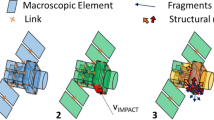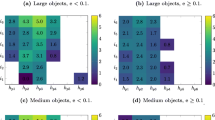Abstract
Simulations of spacecraft breakup events in low lunar orbit are conducted with the aim of determining the longevity of the resulting debris and the hazards it could pose. The trajectories of approximately 97,000 debris particles across eight Monte Carlo breakup simulations are propagated for 1 year using a high-precision lunar trajectory model. Debris was found to be especially long-lasting for breakups in circular polar orbits at 200 km altitude, in retrograde equatorial orbits at 100 km or higher, and in lunar frozen orbits. Analysis of the locations at which polar-orbiting debris tended to impact the Moon reveals a surprising asymmetry and significant accumulations in certain regions. Finally, estimates of the collision probability over 1 year to other notional spacecraft varied from \(10^{-9}\) to \(10^{-13}\), suggesting a low risk of collision, but a significant number of close approaches within 5 km were observed. The results of this study provide new insights into the overall behavior of debris in lunar orbit and improve understanding of the consequences of a debris event in this orbital environment.












Similar content being viewed by others
References
Kessler, D.J., Cour-Palais, B.J.: Collision frequency of artificial satellites: the creation of a debris belt. J. Geophys. Res. 83(A6), 2637–2646 (1978). https://doi.org/10.1029/JA083iA06p02637
Johnson, N.L.: Man-made debris in and from lunar orbit. In: 50th International Astronautical Congress Proceedings (1999)
Meador, J.: Long-term orbit stability of the Apollo 11 “Eagle” lunar module ascent stage. Planetary Space Sci. 205 (2021). https://doi.org/10.1016/j.pss.2021.105304
Boone, N.R., Bettinger, R.A.: Long-term evolution of debris clouds in low lunar orbit. In: 2022 Advanced Maui Optical Surveillance Conference (AMOS) Proceedings (2022)
Lehman, D.H., Hoffman, T.L., Havens, G.G.: The Gravity Recovery and Interior Laboratory mission. In: 2013 IEEE Aerospace Conference Proceedings (2013). https://doi.org/10.1109/AERO.2013.6496866
Vondrak, R., Keller, J., Garvin, J.: Lunar Reconnaissance Orbiter (LRO): observations for lunar exploration and science. Space Sci. Rev. 150, 391–419 (2010). https://doi.org/10.1007/s11214-010-9631-5
Wang, X.-D., Bian, W., Wang, J.-S., Liu, J.-J., Zou, Y.-L., Zhang, H.-B., Lü, C., Liu, J.-Z., Zuo, W., Su, Y., Wen, W.-B., Wang, M., Ouyang, Z.-Y., Li, C.-L.: Acceleration of scattered solar wind protons at the polar terminator of the moon: results from Chang’E-1/SWIDs. Geophys. Res. Lett. 37(7) (2010). https://doi.org/10.1029/2010GL042891
Li, P., Hu, X., Huang, Y., Wang, G., Jiang, D., Zhang, X., Cao, J., Xin, N.: Orbit determination for Chang’E-2 lunar probe and evaluation of lunar gravity models. Sci. China Phys. Mech. Astron. 55, 514–522 (2012). https://doi.org/10.1007/s11433-011-4596-2
Goswami, J.N., Annadurai, M.: Chandrayaan-1 mission to the moon. Acta Astronaut. 63(11), 1215–1220 (2008). https://doi.org/10.1016/j.actaastro.2008.05.013
Sundararajan, V.: Overview and technical architecture of india’s Chandrayaan-2 mission to the moon. In: 2018 AIAA Aerospace Sciences Meeting (2018). https://doi.org/10.2514/6.2018-2178
Kato, M., Sasaki, S., Tanaka, K., Iijima, Y., Takizawa, Y.: The Japanese lunar mission SELENE: science goals and present status. Adv. Space Res. 42(2), 294–300 (2008). https://doi.org/10.1016/j.asr.2007.03.049
Hood, L.L., Zakharian, A., Halekas, J., Mitchell, D.L., Lin, R.P., Acuña, M.H., Binder, A.B.: Initial mapping and interpretation of lunar crustal magnetic anomalies using Lunar Prospector magnetometer data. J. Geophys. Res. 106(E11), 27825–27839 (2001). https://doi.org/10.1029/2000JE001366
Lara, M.: Design of long-lifetime lunar orbits: a hybrid approach. Acta Astronaut. 69(3), 186–199 (2011). https://doi.org/10.1016/j.actaastro.2011.03.009
Park, S.-Y., Junkins, J.: Orbital mission analysis for a lunar mapping satellite. In: Astrodynamics Conference Proceedings (1994). https://doi.org/10.2514/6.1994-3717
Song, Y.-J., Park, S.-Y., Kim, H.-D., Sim, E.-S.: Development of precise lunar orbit propagator and lunar polar orbiter’s lifetime analysis. J. Astron. Space Sci. 27(2), 97–106 (2010). https://doi.org/10.5140/JASS.2010.27.2.097
Hughes, S.: General Mission Analysis Tool (GMAT) technical specifications. NASA Technical Reports Server (1 Jan 2007)
National Aeronautics and Space Administration: a standardized lunar coordinate system for the lunar reconnaissance orbiter and lunar datasets. https://lunar.gsfc.nasa.gov/library/LunCoordWhitePaper-10-08.pdf (1 Oct 2008)
Folkner, W.M., Williams, J.G., Boggs, D.H.: The planetary and lunar ephemeris DE 421. IPN Progr. Rep. 42–178, 15 (2009)
National Aeronautics and Space Administration: lunar gravity field: GRGM1200A. https://pgda.gsfc.nasa.gov/products/50
Battin, R.H.: An Introduction to the Mathematics and Methods of Astrodynamics, Revised Edition, pp. 388–389. American Institute of Aeronautics and Astronautics, Reston, VA (1999)
Meyer, K.W., Buglia, J.J., Desai, P.N.: Lifetimes of lunar satellite orbits. NASA Technical Paper 3394 (1994)
Anselmo, L., Pardini, C.: Long-term dynamical evolution of high area-to-mass ratio debris released into high Earth orbits. Acta Astronaut. 67(1), 204–216 (2010). https://doi.org/10.1016/j.actaastro.2009.10.017
Vallado, D.A.: Fundamentals of Astrodynamics and Applications, pp. 577–578. Microcosm Press, Hawthorne, CA (2007)
Montenbruck, O.: Satellite Orbits: Models, Methods, Applications, pp. 81–83. Springer, Heidelberg (2000)
Johnson, N.L., Krisko, P.H., Liou, J.-C., Anz-Meador, P.D.: NASA’s new breakup model of EVOLVE 4.0. Adv. Space Res. 28(9), 1377–1384 (2001). https://doi.org/10.1016/S0273-1177(01)00423-9
Frey, S., Colombo, C.: Transformation of satellite breakup distribution for probabilistic orbital collision hazard analysis. J. Guid. Control. Dyn. 44(1), 88–105 (2021). https://doi.org/10.2514/1.G004939
Krisko, P.H.: Proper implementation of the 1998 NASA breakup model. Orbital Debris Q. News 15(4), 4–5 (2011)
Weisstein, E.W.: Sphere point picking. Wolfram Research. https://mathworld.wolfram.com/SpherePointPicking.html
Vedder, J.D., Tabor, J.L.: New method for estimating low-earth-orbit collision probabilities. J. Spacecr. Rocket. 28(2), 210–215 (1991). https://doi.org/10.2514/3.26232
McCormick, B.: Collision probabilities in geosynchronous orbit and techniques to control the environment. Adv. Space Res. 6(7), 119–126 (1986). https://doi.org/10.1016/0273-1177(86)90220-6
Lidtke, A.A., Lewis, H.G., Armellin, R.: Statistical analysis of the inherent variability in the results of evolutionary debris models. Adv. Space Res. 59(7), 1698–1714 (2017). https://doi.org/10.1016/j.asr.2017.01.004
Funding
Funding was provided by the Department of the Air Force.
Author information
Authors and Affiliations
Corresponding author
Ethics declarations
Conflict of interest
The authors have nothing to declare, to include any potential conflicts of interest.
Additional information
Publisher's Note
Springer Nature remains neutral with regard to jurisdictional claims in published maps and institutional affiliations.
Rights and permissions
About this article
Cite this article
Boone, N., Bettinger, R. Simulation of Debris Events in Selected Low Lunar Orbits. J Astronaut Sci 70, 16 (2023). https://doi.org/10.1007/s40295-023-00382-y
Accepted:
Published:
DOI: https://doi.org/10.1007/s40295-023-00382-y




